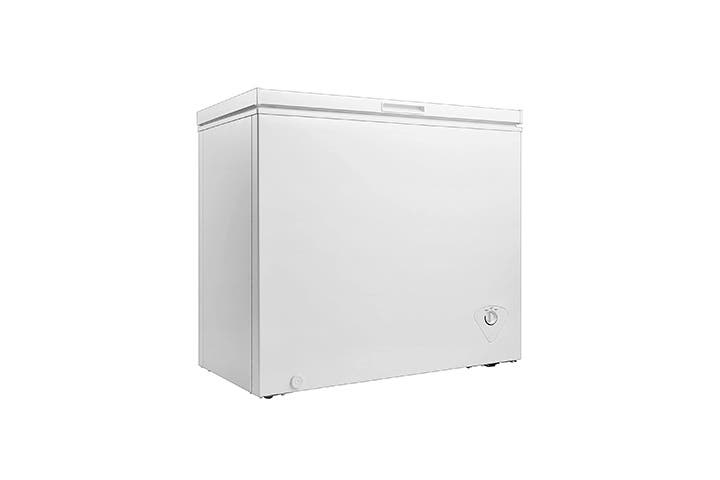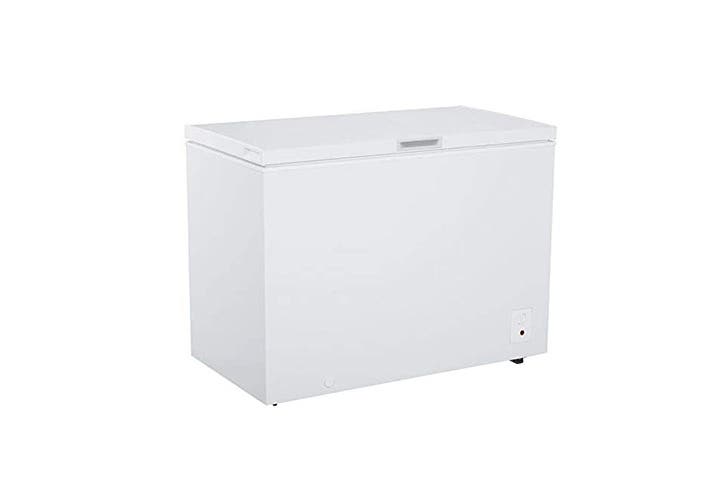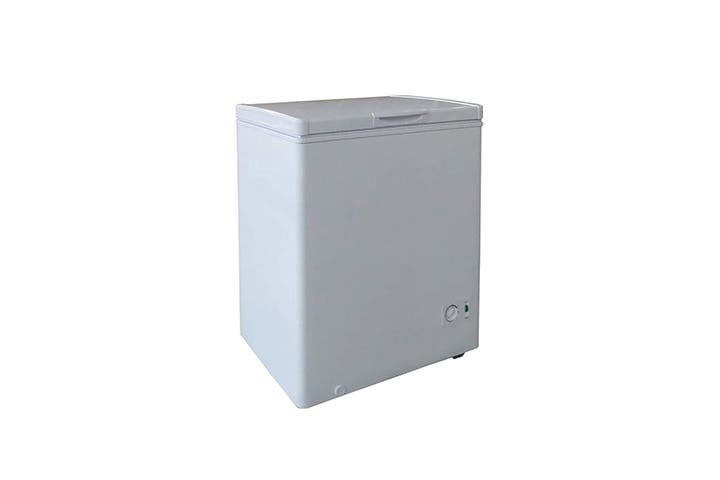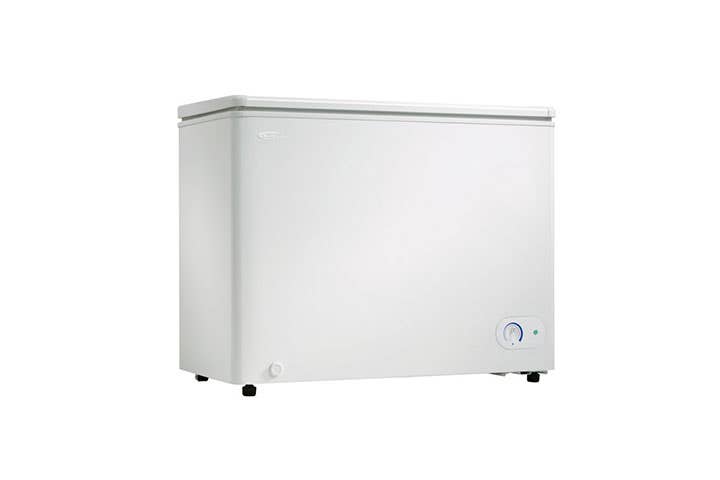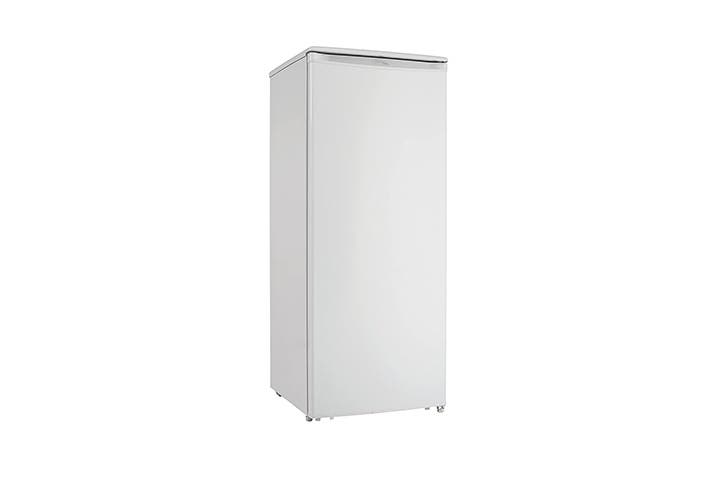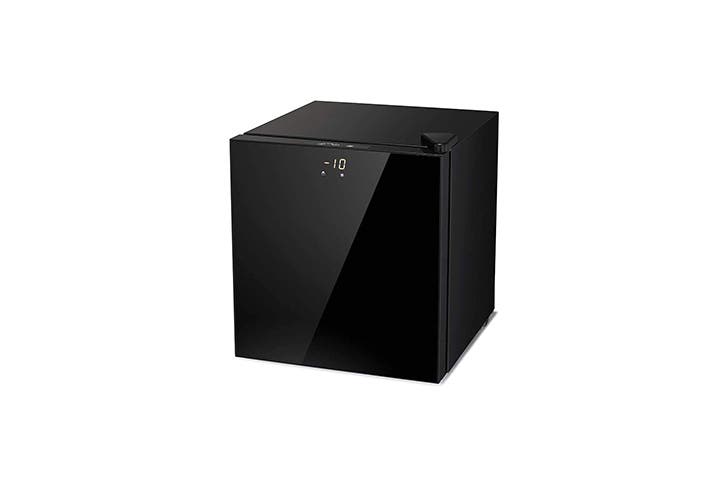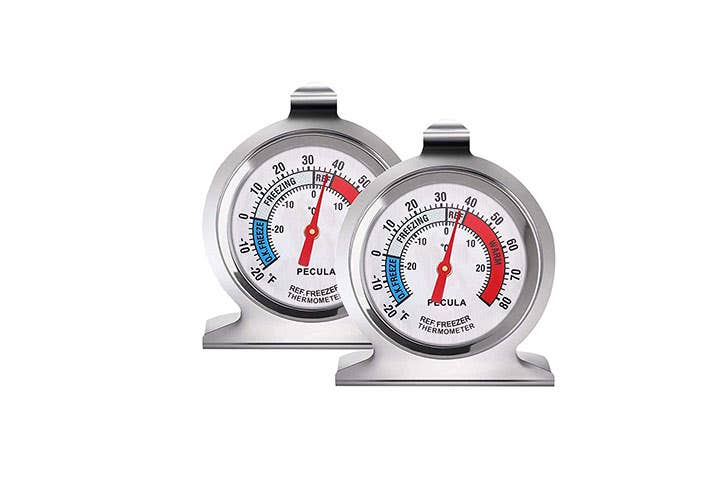The Best Chest Freezers Are Worth the Space
One kitchen extra that more than pulls its weight.

STEFAN TOMIC/GETTY IMAGES
Picture this: You’ve snagged a bargain on organic chicken breasts at the local butcher, or maybe you made way too much of mama’s really good red sauce. You wrap everything well, packing it into zippy bags or food containers, then you open the freezer compartment of your refrigerator to find absolutely no space in there whatsoever. Zip. There’s that homemade ice cream from last week, plus ice cubes for chilling martinis, scrap bread saved for that new French toast recipe (or for croutons or stuffing), some leftover veggies waiting to become stock, even a few squishy reusable freezer packs for bumps and bruises, but no room for much else.
If you’ve ever been frustrated by lack of freezer space, you’re in good company. Most of us have recently been cooking and baking at home more than before, so we have prepped food, staples, plus leftovers, plus, plus, plus. Where to keep it all if not in the freezer?
Hannah Kirshner is a writer, artist and food stylist, and author of Water, Woods & Wild Things, and she knows the value of having extra freezer space. “I grew up on a small farm outside Seattle,” she remembers, “and so we had a standing chest freezer. You know, it looks like a refrigerator. It was always full of meat and vegetables from our farm—and popsicles.”
Valery Lomas, lawyer-turned-baker and author of Life is What You Bake It has a great take on the extra freezer, too, though she has no room for one in her own kitchen right now. “My mom has an extra refrigerator and freezer… it makes a lot of sense,” she says. “If you've got the space, [you can] buy in bulk for the family. People hunt and fish, take advantage of shrimp season and all that kind of stuff.” Lomas’ own idea of a best use for a chest freezer? “That's for my dream house, a chest freezer. And I'll just put butter in it.”
According to Caleb Schwin, a product specialist at Kelly’s Home Center, “Freezers are probably the simplest appliance in the industry. They have not changed, hardly at all in the last 35 years.” Kelly’s Home Center is a family business that’s been an institution in Oregon since 1974, long before Amazon and even before the likes of Home Depot. During that time, the basics have remained the same: There’s an insulated box with a lid or a door, and an electric condenser that keeps the air cold. “It holds temperature,” he says. That’s pretty much it.
There are two basic styles of chest freezer on the market: the chest version, with a lid that lifts up on the top; and the standing or upright style Kirshner refers to, which as she says looks rather like a refrigerator, but with a single door and a single purpose. Which style is best for you, “is more of an aesthetic factor than anything,” Schwin adds, and depends how you want the contents to be organized, and the size of the space in which the freezer will live.
Schwin adds that most freezers, no matter the brand name on the front, are really made by only a few manufacturers. Behind every brand you see—well-known, budget, or otherwise—is a freezer motor manufactured by one of very few companies. So don’t be swayed by brand name alone; look instead for the style, construction, and features that suit your needs.
Because of the size and commitment, this may be one purchase you’ll want to make at a local appliance dealer. For a coast-to-coast comparison, we checked Kelly’s prices and those at Gringer & Sons Appliances in New York, another family-owned institution, against what’s available online. The local stores’ prices are comparable to what you see online, because, let’s face it, they are all competing in the same market. Plus, most local stores also offer delivery.
Whether buying online or checking out chest freezers in a brick-and-mortar store, there are certain basic features you should consider, including the thickness of the box wall (thicker is usually better); the flexibility, durability, and adhesion of the gasket sealing the door or lid; how well and easily the door or lid shuts and stays shut; and whether the exterior finish suits your style.
After that, look at the extras, such as whether the door or lid holds itself open for convenience, or if there’s a kick-plate to open the door with no hands, something that’s only available on the pricier models. Then consider all the interior organization options, baskets, etc.
For an appliance that’s mostly a big insulated box with one job—keeping things cold—that’s about it. These are the best chest freezers we’ve found online.
- Best Overall: Midea 7 Cu. Ft. Chest Freezer
- Best Value: Avanti Freestanding 10 Cu. Ft. Chest Freezer
- Best Chest Style (Smaller): Plastic Development Group Garage or Basement 5 Cu. Ft. Chest Freezer
- Best Chest Style (Mid-size): Danby Garage-Ready 7.2 Cu. Ft. Chest Freezer
- Best Standing Style: Danby Designer Upright Freezer
- Best Really Small Freezer: Small Upright 1.1 Cu. Ft. Freezer
- Best Accessory: 2 Pack Refrigerator Thermometer
Features to Keep in Mind
Storage Space: The real-world, practical capacity of a freezer is determined both by what you’ll be stashing inside and how well you’ll be able to organize and keep track of it all. Standing styles will often have sliding drawers and shelves on the door, like a refrigerator, and chest styles will often have fitted baskets as accessories. Plus, you can add organizing gear to either chest or standing styles in order to help make things more accessible and easier to see.
Drawers and Dividers: Chest-style freezers will often come with one or more fitted basket inserts made of solid plastic or coated wire, and you can sometimes order extras from the dealer. You can also adapt other storage and organizing options to the freezer: canvas shopping bags that can be lifted out, bins that stack, even tied up grocery bags or cardboard boxes will work in a pinch. It’s all about keeping “like with like” and making sure that everything is visible and easy to handle.
Temperature: A freezer—whether integrated with a fridge or standalone—should be kept at 0 degrees Fahrenheit, never above. Many appliances will have built-in temperature read-outs, but those sensors can quietly fail, so it’s worth investing in a simple, manual fridge/freezer thermometer that will allow you to double-check internal temperatures. Checking the temp occasionally is always a good idea, because a fridge or freezer that isn’t holding its temp is always the first sign that either the door isn’t sealing properly, someone is forgetting to close the door, or the appliance needs servicing. Better safe than sorry—those homemade frozen dumplings are worth their weight in gold.
Energy Efficiency: The chest style will be marginally more efficient than the standing style. It’s a matter of simple science: Cold air drops naturally, so opening a freezer from the top doesn’t let as much cold escape, because the coldest air is at the bottom of the freezer box. But opening a freezer door that swings from the front will allow cold air to escape more easily. The kWh/yr (kilowatt hours per year) used by a chest freezer will range from about 150 to as much as 450, but that will depend a lot on its size and how often the door is opened. Once you decide on a model, there’s a great resource at energystar.gov that can help you decide whether the brand and style you want fits comfortably into your energy footprint.
Manual vs. Auto Defrosting:
First, we need to understand how and why frosting happens in a freezer. When a freezer door is opened, warm air flows in from the room, and cold air flows out of the freezer. That imbalance allows frost to occur in the freezer box. So, frost inside a freezer can happen in the moments when the door is standing open, or when the gasket doesn’t seal properly around the door. An auto defrost feature will compensate for the imbalanced temperature with extra-cooled air, but honestly, as long as you don’t stand around with the freezer door hanging open (one of those things your mother warned you not to do anyway), chances are frost won’t be a routine problem. All freezers have the capacity to defrost when they are—of course—turned off, and chest freezers will have a drain at the bottom of the freezer box. Once a year, or once a season, depending on how much you’re storing, plan to empty the freezer and allow it to defrost entirely before cleaning the interior, re-freezing and restocking.
Our Top Picks
Best Overall: Midea 7 Cu. Ft. Chest Freezer
Best Overall
With a footprint under a yard wide, and great capacity, this is an ideal starter freezer because it doesn’t take up a ton of room. It has a stay-open lid, so you aren’t stuck holding it while selecting, and comes with two top-level baskets. It also offers a temperature control, which some people find useful when the freezer lives in a cooler or warmer part of the house.
Best Value for Extra Space: Avanti Freestanding 10 Cu. Ft. Chest Freezer
Best Value for Extra Space
If you have the floor space, this freezer offers great interior storage, but doesn’t have an assisted lid or extra baskets. Consider this larger size if you’re storing bulk amounts of meat or staples that won’t require frequent access.
Best Chest Style (Smaller): Plastic Development Group Garage or Basement 5 Cu. Ft. Chest Freezer
Best Chest Style (Smaller)
This smaller chest freezer is just the basics with one fitted basket and decent interior space, good enough for those extra loaves of bread or extra tubs of ice cream.
Best Chest Style (Mid-size): Danby Garage-Ready 7.2 Cu. Ft. Chest Freezer
Best Chest Style (Mid-size)
This chest freezer touts itself as being “garage-ready.” This is an issue worth considering, because some manufacturers will consider it a violation of the warranty to keep a freezer “outdoors.” In practical use, however, it’s perfectly safe and reasonable to keep a freezer in a basement or garage where it’s generally cooler, as long as temperatures there aren’t truly extreme. Residential refrigerators and freezers aren’t built to work reliably against extremes of temperature.
Best Standing Style: Danby Designer Upright Freezer
Best Standing Style
This substantial standing (upright) freezer is simple and not over-the-top expensive, but still has features that allow it to be easily organized, including shelves on the door and racks in the freezer compartment. While an upright can be marginally less efficient than a chest freezer, its smaller footprint can be helpful in small spaces.
Best Really Small Freezer: Small Upright 1.1 Cu. Ft. Freezer
Best Really Small Freezer
This is a great freezer that serves specific purposes in a small space, like keeping frozen meals in a dorm room or office, or for someone who needs to keep medication at low temperatures. If you have extra countertop space, it’s perfect, and its glass door even doubles as a message board when using dry erase markers. But if it’s destined to sit on the floor, a small standing freezer would have the same footprint, more interior storage, and be only a bit more expensive.
Best Accessory: 2 Pack Refrigerator Thermometer
Best Accessory
Digital readouts and automatic sensors are great, but nothing beats a plain old thermometer. Simply place one (they hang) near the center of both your fridge and your freezer to confirm at a glance that food is kept at a safe temperature.
Ask the Experts
Q: Does a chest freezer use a lot of electricity?
Chest freezers are actually fairly efficient, in part because they only use energy to do one thing, and also because we tend not to be opening and closing them as much as we would a refrigerator.
Q: Can I plug my chest freezer into a regular outlet?
Yes, most home chest freezers are designed to be plugged into a standard AC household outlet. Commercial freezers are another matter, but home chest freezers are plug-and-play. That said, there are chest freezers that are designed specifically to run on the DC current (12 or 24 volts) from a car’s cigarette lighter. This can be useful if you’re in a remote location, off the grid, or need something that can run easily on solar power (or even golf-cart batteries!)
Q: How should I maintain my chest freezer?
The two biggest things to watch for in chest freezers (or in refrigerators, for that matter) are food spills and leaks, or doors that are left standing open or ajar. Avoid such small crises in advance by making sure everything that goes into the freezer is properly sealed or lidded. As for doors left ajar, some newer, fancier appliances have a warning that sounds if a door is open. If the door gasket on a chest freezer isn’t sealed, or if something like a bread bag or other errant bit of packaging impedes the seal, the air leakage will cause frost, and therefore, the need to completely defrost the freezer.
Our Take
Once you have a chest freezer, you’ll find it easily filled, whether you keep it stocked with butter or seasonal produce. And once you decide you need one, you’ll want to pick the best chest freezer for your needs. They’re incredibly efficient in what they do, aren’t terribly expensive, and whether chest-style or standing, can have a footprint smaller than a standard refrigerator. The chest style-freezer can even double as a counter or work space when it’s closed, or be covered entirely with something either practical (a large cutting board, perhaps) or decorative (fabric that matches the room). You’ll love knowing that it’s so easy to find the frozen peas now that they aren’t buried behind those extra bags of coffee beans you got on sale.
Keep Reading
Continue to Next Story
